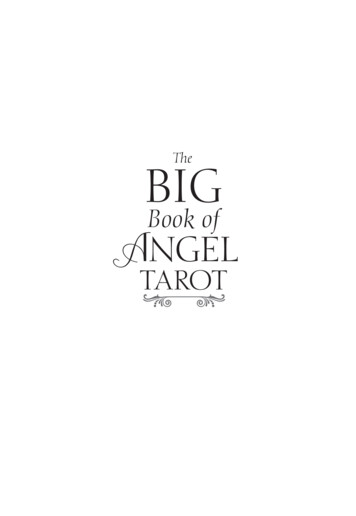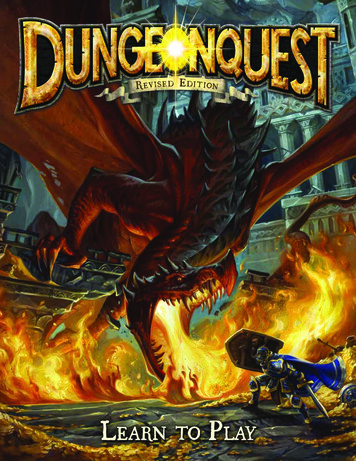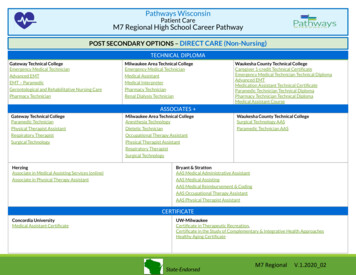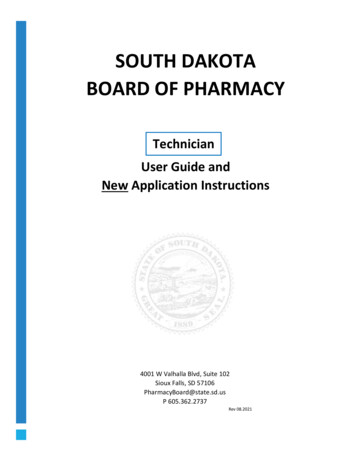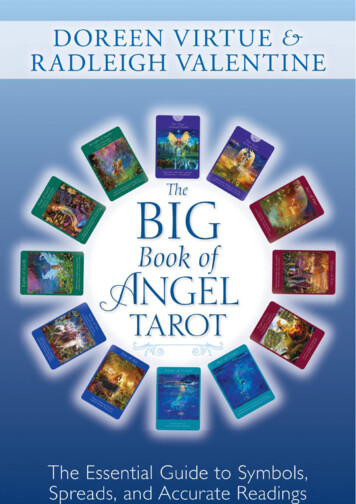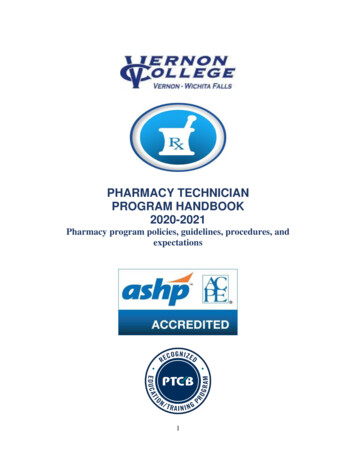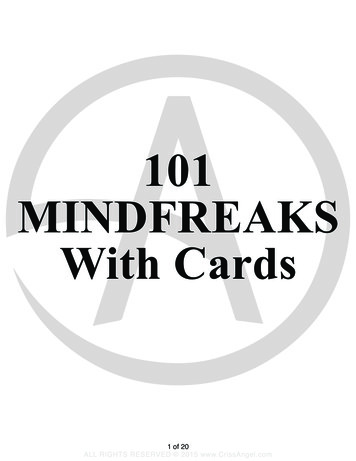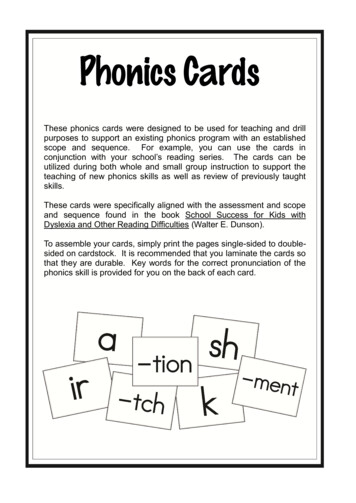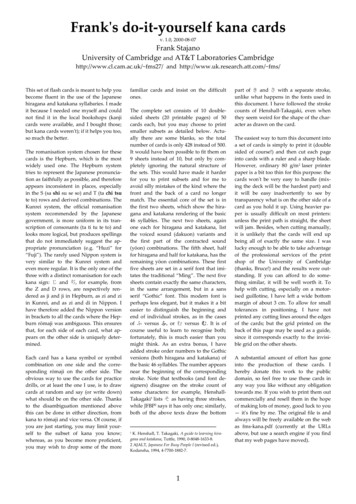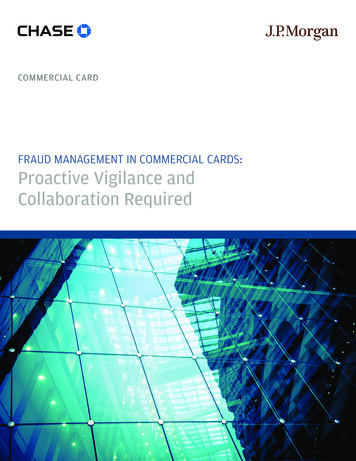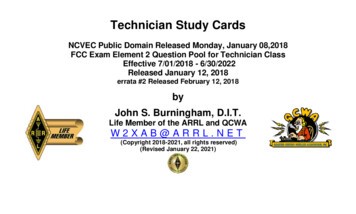
Transcription
Technician Study CardsNCVEC Public Domain Released Monday, January 08,2018FCC Exam Element 2 Question Pool for Technician ClassEffective 7/01/2018 - 6/30/2022Released January 12, 2018errata #2 Released February 12, 2018byJohn S. Burningham, D.I.T.Life Member of the ARRL and QCWAW2XAB@ARRL.NET(Copyright 2018-2021, all rights reserved)(Revised January 22, 2021)
ForwardThis deck of cards is to study for the test. I do not necessarily agree withpassing Amateur Exams by only knowing the answers to the questionpool, so I have added some extra material.Hopefully individuals passing the exam will become actively involved inthe hobby and further learn the technology with the help of clubs andmentors after obtaining their license.This document is available from http://technician.k4usd.org.Permission is NOT granted to distribute on the web except via linksto the above URL. This is so only the current version will be usedby anyone wanting a copy.
How did it all start(This is not on the test)A very long time ago the earth was formed out of stellar matter. Lifebegan on this planet and after many millions of years man evolved. Mandiscovered fire and developed language, followed closely by the creationof religion, government and war. Roads were built to allow governmentcommunications to move quickly throughout their realm and armies tomarch to distant points.The earliest wireless long-distance communications used sound andvisual signals to carry messages (drums, mirrors and smoke signals).In 1753, an anonymous writer in the Scots Magazine suggested anelectrostatic telegraph using one wire for each letter. The firstelectrostatic telegraph was installed in a rich nobleman’s home in 1774
connecting two rooms; I assume one room was the kitchen, so foodcould be ordered for the servants to deliver.Towers and hill top sites were built to relay visual signals (semaphore)over long distances starting in 1793 France.In 1835 the first telegraph lines were installed along a German railroad.Elderton PA as the site of the first American electric telegraph in 1836,developed by Dr. David Alter.The first telegram in the United States was sent by Samuel F. B. Morseon 11 January 1838.The end of the Pony Express began on October 24, 1861 when the westand east coasts of the US were connected with an overland telegraphsystem.
The first successful trans-Atlantic telegraph cable was completed in July1866. Earlier attempts in 1857, 1858, and 1865 failed after very shortperiods (hours and days) of time.In 1873, James Clerk Maxwell presented his theory of theelectromagnetic field.In 1901 Guglielmo Marconi communicated across the Atlantic with aradio device using high power and giant antennas.Congress approved the Radio Act of 1912, which required amateurs tobe licensed and restricted to the single wavelength of 200 meters.In 1914 the American Radio Relay League was founded by Hiram PercyMaxim, who found that messages could be sent more reliably over longdistances if relay stations were organized.
The Federal Radio Commission (FRC) was created in 1926, replaced bythe Federal Communications Commission (FCC) in 1934.In 1934, Edwin Armstrong developed Frequency Modulation (FM) whichsoon became adopted by broadcasters and police two-way radios.Amateur repeaters in the 21st century are migrating from the traditionalanalog FM repeaters to newer more efficient digital technology such asDMR, D-Star, Fusion, NXDN, and P25.Today amateur radio is active in almost all nations, including theInternational Space Station. There are currently over 40 OSCAR(Orbiting Satellite Carrying Amateur Radio) satellites in orbit. Hopefullywe will have an amateur station on Mars in the foreseeable future.
The Structure of the Amateur Radio ExamsPrior to 1984, the FCC administered and maintained the testing for AmateurRadio licenses. Due mainly to governmental budget cuts the responsibility wasturned over the amateur community.Subpart F of the FCC Amateur Rules and Regulations Part 97 regulates theexamination process.The question pool is developed today per 47CFR97.523 by theNational Conference of Volunteer Examiner Coordinators and revised every fewyears on a rotating basis for all three elements: Technician (Element 2), General(Element 3), and Extra (Element 4). The question pools per 97.523 are requiredto be made public.Element 2 consists of ten sub-elements (T1-T0), with a total of 35 groups ofquestion. One question from each group is selected for each examination. Apassing score is 26 out of 35 questions.
The tests are administered by teams of Volunteer Examiners (VEs), managed bya VE session manager who are all accredited by a Volunteer ExaminerCoordinator (VEC).A minimum of three VEs qualified to administer an element is required; they areresponsibility to maintain the integrity of the examination process and grading ofresults. The VE session manager reports the results to the VEC which enters theinformation into the FCC database; it is the FCC that grants the license. The FCCno longer mails printed copies and you can start operating as soon as yourlicense grant appears in the FCC ULS (Universal Licensing System) databasewhich is accessible at http://www.fcc.gov.If you fail an examination element you may be able to retake the test the sameday (different version) if allowed by the VE team; each attempt requires paymentof the testing fee (amount determined by the VEC in accordance of 97.527).If is allowable to take two or three different elements for the one test fee. Youmust pass Element 2 to receive a Technician license, Elements 2 and 3 to
receive a General license, and Elements 2, 3 and 4 to earn the Extra license.Element credit is given based upon 97.505, a CSCE (Certificate of SuccessfulCompletion of Examination) will be issued that is valid for 365 days forelements passed but not qualifying for a license; do not lose it as you mustpresent it at a future examining session to receive element credit.Special testing is allowed for handicap individuals with prior request to the VEsession manager including but not limited to oral admission of the test, testwithout any questions that require figures and special testing sessions at otherlocations for those who cannot attend a regular scheduled testing session.Applicant are required to provide identification and a FRN (FCC RegistrationNumber). Identification requirements include two forms of acceptable IDs (onemust be a government photo ID); there are special identification requirements forminors without government photo IDs.
You may obtain your FRN if you do not already have one stration-commission-registration-system.I must use your FRN for the examination to avoid any identify theft issues ofhaving to supply your SSN. If you do not qualify for an SSN, you must get anFRN; this applies to foreign nationals who may not qualify for an SSN.As of February 1, 2021, the FCC is charging a 35 fee in addition to any VECtesting fee.You can access the official copy of Title 47 of the Code of Federal Regulations(CFR) which contain Part 97 at:https://www.ecfr.gov/cgi-bin/text-idx?tpl /ecfrbrowse/Title47/47tab 02.tpl
The format of the following question deck:Tegnn“T” indicates Element 2 (Technician) pool.“e” is the subelement number.“g” is the group letter.“nn” is the question number in the group.If the question directly relates to FCC rule(s), they will be listed in squarebrackets “[97.nnn]” for reference only.There are always four possible answers (A-D). The incorrect answersare grayed out, the correct answer is highlighted in bold face GREEN.It is better to not read (ignore) the incorrect answers when studying.
If selection “D. All of these choices are correct” is the correct answer,selections A-C will also be in Green but not bold faced because they arecorrect answers, but not the one you must select.Figures required to answer questions on the real exam will not be withthe questions but on a separate page, I have included them with thequestion and highlighted the area of the figure referenced in thequestion.Text and photos in a box are to assist you in learning,URLs and linked text are for additional web sources.
SUBELEMENT T1 – FCC Rules, descriptions, anddefinitions for the Amateur Radio Service, operator andstation license responsibilities [6 Exam Questions - 6 Groups]T1A - Amateur Radio Service: purpose and permissibleuse of the Amateur Radio Service, operator/primarystation license grant; Meanings of basic terms usedin FCC rules; Interference; RACES rules; Phonetics;Frequency Coordinator
T1A01 [97.1]Which of the following is a purpose of the AmateurRadio Service as stated in the FCC rules andregulations?A. Providing personal radio communications for asmany citizens as possibleB. Providing communications for international nonprofit organizationsC. Advancing skills in the technical andcommunication phases of the radio artD. All of these choices are correct
T1A02 [97.1]Which agency regulates and enforces the rules for theAmateur Radio Service in the United States?A.B.C.D.FEMAHomeland SecurityThe FCCAll of these choices are correct
T1A03 [97.119(b)(2)]What are the FCC rules regarding the use of aphonetic alphabet for station identification in theAmateur Radio Service?A. It ismessagesB. It isC. It isstationsD. It isrequired when transmitting emergencyprohibitedrequired when in contact with foreignencouraged
T1A04 [97.5(b)(1)]How many operator/primary station license grants maybe held by any one person?A. OneB. No moreC. One foroperateD. One forthe personthan twoeach band on which the person plans toeach permanent station location from whichplans to operate
T1A05 [97.7]What is proof of possession of an FCC-issuedoperator/primary license grant?A. A printed operator/primary station license issuedby the FCC must be displayed at the transmitter siteB. The control operator must have an operator/primarystation license in his or her possession when incontrol of a transmitterC. The control operator's operator/primary stationlicense must appear in the FCC ULS consolidatedlicensee databaseD. All of these choices are correct
T1A06 [97.3(a)(9)]What is the FCC Part 97 definition of a "beacon"?A. A government transmitter marking the amateur radioband edgesB. A bulletin sent by the FCC to announce a nationalemergencyC. An amateur station transmitting communications forthe purposes of observing propagation or relatedexperimental activitiesD. A continuous transmission of weather informationauthorized in the amateur bands by the NationalWeather Service
T1A07 [97.3(a)(41)]What is the FCC Part 97 definition of a "spacestation"?A. Any satellite orbiting the earthB. A manned satellite orbiting the earthC. An amateur station located more than 50 km abovethe Earth's surfaceD. An amateur station using amateur radio satellitesfor relay of signals
T1A08 [97.3(a)(22)]Which of the following entities recommendstransmit/receive channels and other parameters forauxiliary and repeater stations?A. Frequency Spectrum Manager appointed by the FCCB. Volunteer Frequency Coordinator recognized bylocal amateursC. FCC Regional Field OfficeD. International Telecommunications Union
T1A09 [97.3(a)(22)]Who selects a Frequency Coordinator?A. The FCC Office of Spectrum Management andCoordination PolicyB. The local chapter of the Office of NationalCouncil of Independent Frequency CoordinatorsC. Amateur operators in a local or regional areawhose stations are eligible to be repeater orauxiliary stationsD. FCC Regional Field Office
T1A10 [97.3(a)(38), 97.407]Which of the following describes the Radio AmateurCivil Emergency Service (RACES)?A. A radio service using amateur frequencies foremergency management or civil defense communicationsB. A radio service using amateur stations foremergency management or civil defense communicationsC. An emergency service using amateur operatorscertified by a civil defense organization as beingenrolled in that organizationD. All of these choices are correct
T1A11 [97.101 (d)]When is willful interference to other amateur radiostations permitted?A. To stop another amateur station which is breakingthe FCC rulesB. At no timeC. When making short test transmissionsD. At any time, stations in the Amateur Radio Serviceare not protected from willful interference
T1B - Authorized frequencies: frequency allocations;ITU; emission modes; restricted sub-bands; spectrumsharing; transmissions near band edges; contactingthe International Space Station; power output
T1B01 (B)What is the International Telecommunications Union(ITU)?A. An agency of the United States Department ofTelecommunications ManagementB. A United Nations agency for information andcommunication technology issuesC. An independent frequency coordination agencyD. A department of the FCC
T1B02 [97.301, 97.207(c)]Which amateur radio stations may make contact with anamateur radio station on the International SpaceStation (ISS) using 2 meter and 70 cm bandfrequencies?A. Only members of amateur radio clubs at NASAfacilitiesB. Any amateur holding a Technician or higher-classlicenseC. Only the astronaut's family members who are hamsD. Contacts with the ISS are not permitted on amateurradio frequencies
T1B03 [97.301(a)]Which frequency is within the 6 meter amateur band?A.B.C.D.49.00 MHz52.525 MHz28.50 MHz222.15 MHz
T1B04 [97.301(a)]Which amateur band are you using when your station istransmitting on 146.52 MHz?A.B.C.D.2 meter band20 mete14 meter band6 meter band
T1B05 [97.305(c)]What is the limitation for emissions on thefrequencies between 219 and 220 MHz?A.B.C.D.Spread spectrum onlyFixed digital message forwarding systems onlyEmergency traffic onlyFast-scan television only
T1B06 [97.301(e), 97.305]On which HF bands does a Technician class operatorhave phone privileges?A.B.C.D.None10 meter band only80 meter, 40 meter, 15 meter and 10 meter bands30 meter band only
T1B07 (A) [97.305(a), (c)]Which of the following VHF/UHF frequency ranges arelimited to CW only?A.B.C.D.50.0 MHz to 50.1 MHz and 144.0 MHz to 144.1 MHz219 MHz to 220 MHz and 420.0 MHz to 420.1 MHz902.0 MHz to 902.1 MHZAll of these choices are correct
T1B08 [97.303]Which of the following is a result of the fact thatthe Amateur Radio Service is secondary in all orportions of some amateur bands (such as portions ofthe 70 cm band)?A. U.S. amateurs may find non-amateur stations inthose portions, and must avoid interfering with themB. U.S. amateurs must give foreign amateur stationspriority in those portionsC. International communications are not permitted inthose portionsD. Digital transmissions are not permitted in thoseportions
T1B09 (D) [97.101(a), 97.301(a-e)]Why should you not set your transmit frequency to beexactly at the edge of an amateur band or sub-band?A. To allow for calibration error in the transmitterfrequency displayB. So that modulation sidebands do not extend beyondthe band edgeC. To allow for transmitter frequency driftD. All of these choices are correctNote: A/B/C are all correct, you must select D.
T1B10 [97.301(e), 97.305(c)]Which of the following HF bands have frequenciesavailable to the Technician class operator for RTTYand data transmissions?A.B.C.D.10103010meter, 12 meter, 17 meter, and 40 meter bandmeter, 15 meter, 40 meter, and 80 meter bandmeter band onlymeter band only
T1B11 (A) [97.313]What is the maximum peak envelope power output forTechnician class operators using their assignedportions of the HF bands?A.B.C.D.200 watts100 watts50 watts10 watts
T1B12 (D) [97.313(b)]Except for some specific restrictions, what is themaximum peak envelope power output for Technicianclass operators using frequencies above 30 MHz?A.B.C.D.50 watts100 watts500 watts1500 watts
T1C - Operator licensing: operator classes;sequential and vanity call sign systems;international communications; reciprocal operation;places where the Amateur Radio Service is regulatedby the FCC; name and address on FCC license database;license term; renewal; grace period
T1C01 [97.9(a), 97.17(a)]For which license classes are new licenses currentlyavailable from the FCC?A.B.C.D.Novice, Technician, General, AdvancedTechnician, Technician Plus, General, AdvancedNovice, Technician Plus, General, AdvancedTechnician, General, Amateur Extra
T1C02 [97.19]Who may select a desired call sign under the vanitycall sign rules?A. Only a licensed amateurExtra class licenseB. Only a licensed amateurclass licenseC. Only a licensed amateurcontinuously for more thanD. Any licensed amateurwith a General or Amateurwith an Amateur Extrawho has been licensed10 years
T1C03 [97.117]What types of international communications is an FCClicensed amateur radio station permitted to make?A. Communications incidental to the purposes of theAmateur Radio Service and remarks of a personalcharacterB. Communications incidental to conducting businessor remarks of a personal natureC. Only communications incidental to contestexchanges, all other communications are prohibitedD. Any communications that would be permitted by aninternational broadcast station
T1C04 [97.107]When are you allowed to operate your amateur stationin a foreign country?A. When the foreign country authorizes itB. When there is a mutual agreement allowing thirdparty communicationsC. When authorization permits amateur communicationsin a foreign languageD. When you are communicating with non-licensedindividuals in another country
T1C05Which of the following is a valid call sign for aTechnician class amateur radio station?A.B.C.D.K1XXXKA1XW1XXAll of these choices are correct
T1C06 [97.5(a)(2)]From which of the following locations may an FCClicensed amateur station transmit?A. From within any country that belongs to theInternational Telecommunications UnionB. From within any country that is a member of theUnited NationsC. From anywhere within InternationalTelecommunications Union (ITU) Regions 2 and 3D. From any vessel or craft located in internationalwaters and documented or registered in the UnitedStates
T1C07 [97.23]What may result when correspondence from the FCC isreturned as undeliverable because the grantee failedto provide and maintain a correct mailing addresswith the FCC?A. Fine or imprisonmentB. Revocation of the station license or suspension ofthe operator licenseC. Require the licensee to be re-examinedD. A reduction of one rank in operator class
T1C08 [97.25]What is the normal term for an FCC-issued primarystation/operator amateur radio license grant?A.B.C.D.Five yearsLifeTen yearsTwenty years
T1C09 [97.21(a)(b)]What is the grace period following the expiration ofan amateur license within which the license may berenewed?A.B.C.D.Two yearsThree yearsFive yearsTen years
T1C10 [97.5a]How soon after passing the examination for your firstamateur radio license may you operate a transmitteron an Amateur Radio Service frequency?A. ImmediatelyB. 30 days after the test dateC. As soon as your operator/station license grantappears in the FCC’s license databaseD. You must wait until you receive your license inthe mail from the FCC
T1C11 [97.21(b)]If your license has expired and is still within theallowable grace period, may you continue to operate atransmitter on Amateur Radio Service frequencies?A. No, transmitting is not allowed until the FCClicense database shows that the license has beenrenewedB. Yes, but only if you identify using the suffix GPC. Yes, but only during authorized netsD. Yes, for up to two years
T1D - Authorized and prohibited transmission:communications with other countries; music; exchangeof information with other services; indecentlanguage; compensation for use of station;retransmission of other amateur signals; codes andciphers; sale of equipment; unidentifiedtransmissions; one-way transmission
T1D01 [97.111(a)(1)]With which countries are FCC-licensed amateur radiostations prohibited from exchanging communications?A. Any country whose administration has notified theInternational Telecommunications Union (ITU) that itobjects to such communicationsB. Any country whose administration has notified theAmerican Radio Relay League (ARRL) that it objects tosuch communicationsC. Any country engaged in hostilities with anothercountryD. Any country in violation of the War Powers Act of1934
T1D02 (B) [97.113(b),97.111(b)]Under which of the following circumstances may anamateur radio station make one-way transmissions?A. Under no circumstancesB. When transmitting code practice, informationbulletins, or transmissions necessary to provideemergency communicationsC. At any time, as long as no music is transmittedD. At any time, as long as the material beingtransmitted did not originate from a commercialbroadcast station
T1D03 [97.211(b), 97.215(b), 97.114(a)(4)]When is it permissible to transmit messages encodedto hide their meaning?A. Only during contestsB. Only when operating mobileC. Only when transmitting control commands to spacestations or radio control craftD. Only when frequencies above 1280 MHz are used
T1D04 [97.113(a)(4), 97.113(c)]Under what conditions is an amateur stationauthorized to transmit music using a phone emission?A. When incidental to an authorized retransmission ofmanned spacecraft communicationsB. When the music produces no spurious emissionsC. When the purpose is to interfere with an illegaltransmissionD. When the music is transmitted above 1280 MHz
T1D05 [97.113(a)(3)(ii)]When may amateur radio operators use their stationsto notify other amateurs of the availability ofequipment for sale or trade?A. When the equipment is normally used in an amateurstation and such activity is not conducted on aregular basisB. When the asking price is 100.00 or lessC. When the asking price is less than its appraisedvalueD. When the equipment is not the personal property ofeither the station licensee or the control operatoror their close relatives
T1D06 [97.113(a)(4)]What, if any, are the restrictions concerningtransmission of language that may be consideredindecent or obscene?A. The FCC maintains a list of words that are notpermitted to be used on amateur frequenciesB. Any such language is prohibitedC. The ITU maintains a list of words that are notpermitted to be used on amateur frequenciesD. There is no such prohibitionWhile the FCC has not specifically defined indecent and obscene language, it is doubtful the courtswould uphold it because of the First Amendment except in the broadcasting service. ADVOID theexpense of having to defend your First Amendment Rights, you will most likely win but it would beexpensive and only the lawyers will win ( ).
T1D07 [97.113(d)]What types of amateur stations can automaticallyretransmit the signals of other amateur stations?A.B.C.D.Auxiliary, beacon, or Earth stationsRepeater, auxiliary, or space stationsBeacon, repeater, or space stationsEarth, repeater, or space stations
T1D08 [97.113(a)(3)(iii)]In which of the following circumstances may thecontrol operator of an amateur station receivecompensation for operating that station?A. When the communication is related to the sale ofamateur equipment by the control operator's employerB. When the communication is incidental to classroominstruction at an educational institutionC. When the communication is made to obtain emergencyinformation for a local broadcast stationD. All of these choices are correct
T1D09 [97.113(5)(b)]Under which of the following circumstances areamateur stations authorized to transmit signalsrelated to broadcasting, program production, or newsgathering, assuming no other means is available?A. Only where such communications directly relate tothe immediate safety of human life or protection ofpropertyB. Only when broadcasting communications to or from thespace shuttleC. Only where noncommercial programming is gathered andsupplied exclusively to the National Public Radio networkD. Only when using amateur repeaters linked to the internet
T1D10 [97.3(a)(10)]What is the meaning of the term “broadcasting” in theFCC rules for the Amateur Radio Service?A. Two-way transmissions by amateur stationsB. Transmission of musicC. Transmission of messages directed only to amateuroperatorsD. Transmissions intended for reception by thegeneral public
T1D11 [97.119(a)]When may an amateur station transmit without on-theair identification?A. When the transmissions are of a brief nature tomake station adjustmentsB. When the transmissions are unmodulatedC. When the transmitted power level is below 1 wattD. When transmitting signals to control model craft
T1E - Control operator and control types: controloperator required; eligibility; designation ofcontrol operator; privileges and duties; controlpoint; local, automatic and remote control; locationof control operator
T1E01 [97.7(a)]When is an amateur station permitted to transmitwithout a control operator?A. When using automatic control, such as in the caseof a repeaterB. When the station licensee is away and anotherlicensed amateur is using the stationC. When the transmitting station is an auxiliarystationD. Never
T1E02 [97.301, 97.207(c)]Who may be the control operator of a stationcommunicating through an amateur satellite or spacestation?A. Only an Amateur Extra Class operatorB. A General class or higher licensee who has asatellite operator certificationC. Only an Amateur Extra Class operator who is alsoan AMSAT memberD. Any amateur whose license privileges allow them totransmit on the satellite uplink frequency
T1E03 [97.103(b)]Who must designate the station control operator?A.B.C.D.TheTheTheThestation licenseeFCCfrequency coordinatorITU
T1E04 [97.103(b)]What determines the transmitting privileges of anamateur station?A. The frequency authorized by the frequencycoordinatorB. The frequencies printed on the license grantC. The highest class of operator license held byanyone on the premisesD. The class of operator license held by the controloperator
T1E05 [97.3(a)(14)]What is an amateur station control point?A. The location of the station’s transmitting antennaB. The location of the station transmitting apparatusC. The location at which the control operatorfunction is performedD. The mailing address of the station licensee
T1E06 [97.301]When, under normal circumstances, may a Technicianclass licensee be the control operator of a stationoperating in an exclusive Amateur Extra classoperator segment of the amateur bands?A. At no timeB. When operating a special event stationC. As part of a multi-operator contest teamD. When using a club station whose trustee is anAmateur Extra class operator licensee
T1E07 [97.103(a)]When the control operator is not the stationlicensee, who is responsible for the proper operationof the station?A. All licensed amateurs who are present at theoperationB. Only the station licenseeC. Only the control operatorD. The control operator and the station licensee areequally responsible
T1E08 [97.3(a)(6), 97.205(d)]Which of the following is an example of automaticcontrol?A. Repeater operationB. Controlling the station over the internetC. Using a computer or other device to send CWautomaticallyD. Using a computer or other device to identifyautomatically
T1E09 [97.109(c)]Which of the following is true of remote controloperation?A. The control operator must be at the control pointB. A control operator is required at all timesC. The control operator indirectly manipulates thecontrolsD. All of these choices are correctNote: A/B/C are all correct, you must select D.
T1E10 [97.3(a)(39)]Which of the following is an example of remotecontrol as defined in Part 97?A. Repeater operationB. Operating the station over the internetC. Controlling a model aircraft, boat, or car byamateur radioD. All of these choices are correct
T1E11 [97.103(a)]Who does the FCC presume to be the control operatorof an amateur station, unless documentation to thecontrary is in the station records?A.B.C.D.TheTheTheThestation custodianthird-party participantperson operating the station equipmentstation licensee
T1F - Station identification; repeaters; third-partycommunications; club stations; FCC inspection
T1F01 [97.103(c)]When must the station licensee make the station andits records available for FCC inspection?A. At any time ten days after notification by the FCCof such an inspectionB. At any time upon request by an FCC representativeC. Only after failing to comply with an FCC notice ofviolationD. Only when presented with a valid warrant by an FCCofficial or government agent
T1F02 (C) [97.119 (a)]When using tactical identifiers such as “RaceHeadquarters” during a community service netoperation, how often must your station transmit thestation’s FCC-assigned call sign?A. Never, the tactical call is sufficientB. Once during every hourC. At the end of each communication and every tenminutes during a communicationD. At the end of every transmission
T1F03 [97.119(a)]When is an amateur station required to transmit itsassigned call sign?A. At the beginning of each contact, and every 10minutes thereafterB. At least once during each transmissionC. At least every 15 minutes during and at the end ofa communicationD. At least every 10 minutes during and at the end ofa communicationWhile not required, it is a good operating practice to identify on your firsttransmission, especially when using repeaters.
T1F04 [97.119(b)(2)]Which of the following is an acceptable language touse for station identification when operating in aphone sub-band?A.B.C.D.Any language recognized by the United NationsAny language recognized by the ITUThe English languageEnglish, French, or Spanish
T1F05 [97.119(b)(2)]What method of call sign identification is requiredfor a station transmitting phone signals?A.B.C.D.SendSendSendSendthethethethecal
Technician Study Cards NCVEC Public Domain Released Monday, January 08,2018 FCC Exam Element 2 Question Pool for Technician Class Effective 7/01/2018 - 6/30/2022 Released January 12, 2018 errata #2 Released February 12, 2018 by John S. Burningham, D.I.T. Lif
